UK College Entrepreneurship and Venture Report - Unit 9
VerifiedAdded on 2021/02/20
|12
|2696
|393
Report
AI Summary
This report provides a comprehensive analysis of entrepreneurship and small business management. It begins by defining entrepreneurship and exploring different types of entrepreneurial ventures, including social, private, public, and scalable enterprises, relating them to the typology of entrepreneurship. The report then delves into the similarities and differences between these ventures, considering their objectives, capital structures, and examples. Furthermore, the report examines the impact of SMEs on the UK economy, using relevant data and statistics to illustrate their contributions to employment, turnover, and overall economic growth. The report also explores the influence of SMEs on the social economy, highlighting their role in improving the quality of life and reducing poverty. The report uses the context of the assignment brief that was given to the student to complete this assignment, and this document is available on Desklib, a platform which provides all the necessary AI based study tools for students.
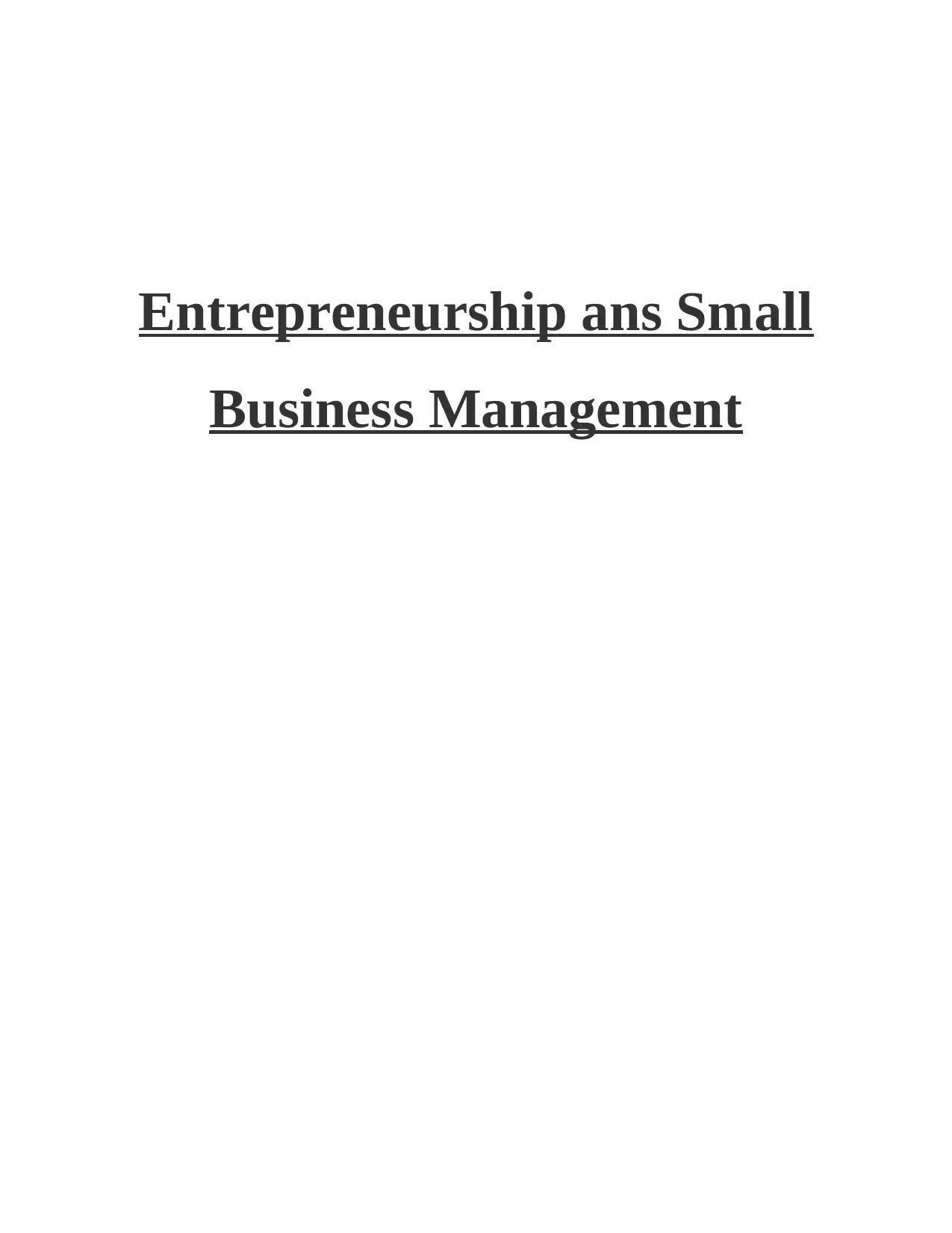
Entrepreneurship ans Small
Business Management
Business Management
Paraphrase This Document
Need a fresh take? Get an instant paraphrase of this document with our AI Paraphraser
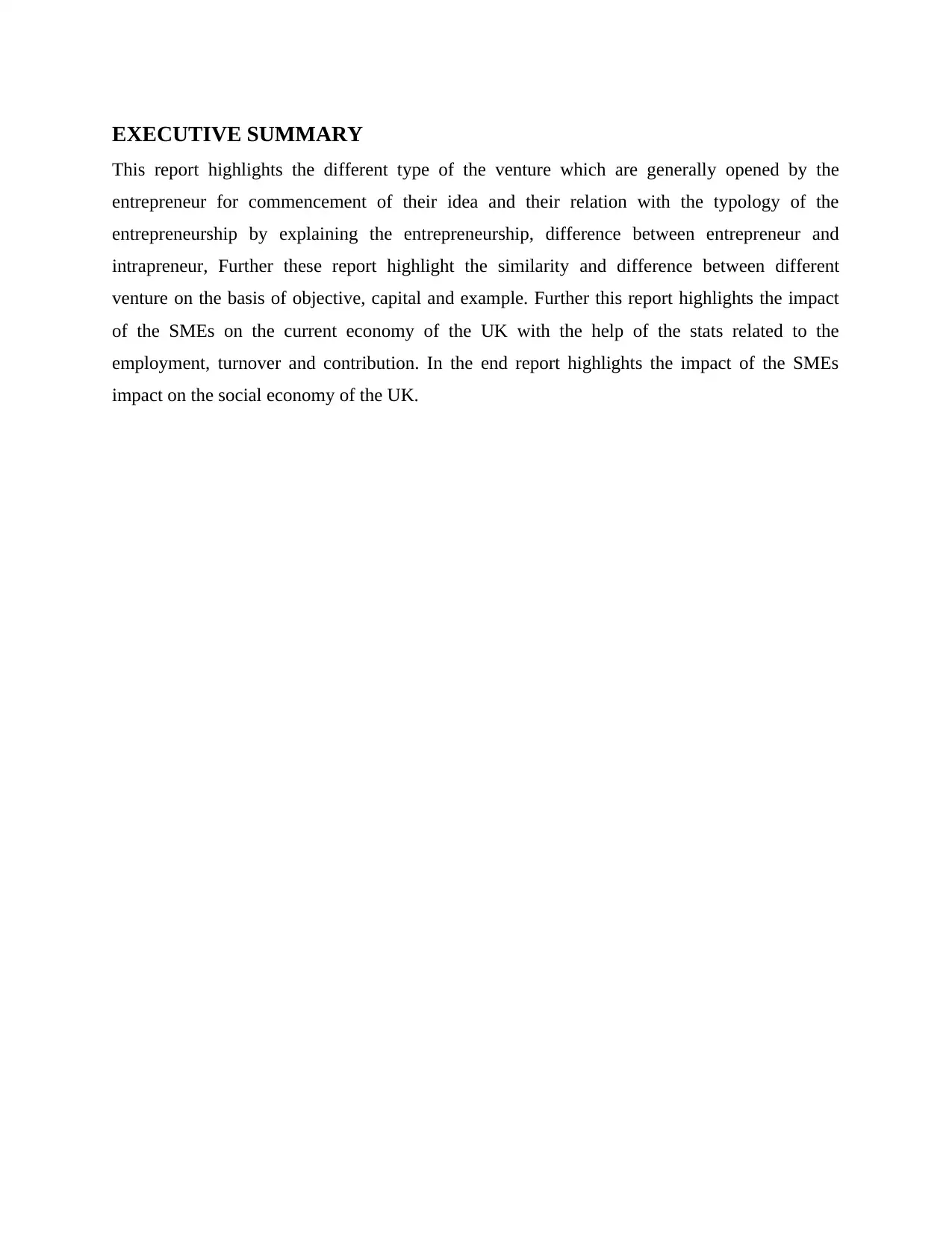
EXECUTIVE SUMMARY
This report highlights the different type of the venture which are generally opened by the
entrepreneur for commencement of their idea and their relation with the typology of the
entrepreneurship by explaining the entrepreneurship, difference between entrepreneur and
intrapreneur, Further these report highlight the similarity and difference between different
venture on the basis of objective, capital and example. Further this report highlights the impact
of the SMEs on the current economy of the UK with the help of the stats related to the
employment, turnover and contribution. In the end report highlights the impact of the SMEs
impact on the social economy of the UK.
This report highlights the different type of the venture which are generally opened by the
entrepreneur for commencement of their idea and their relation with the typology of the
entrepreneurship by explaining the entrepreneurship, difference between entrepreneur and
intrapreneur, Further these report highlight the similarity and difference between different
venture on the basis of objective, capital and example. Further this report highlights the impact
of the SMEs on the current economy of the UK with the help of the stats related to the
employment, turnover and contribution. In the end report highlights the impact of the SMEs
impact on the social economy of the UK.

Table of Contents
EXECUTIVE SUMMARY.............................................................................................................2
INTRODUCTION...........................................................................................................................4
MAIN BODY...................................................................................................................................4
TASK 1............................................................................................................................................4
P1 Explain Different type of the entrepreneur venture related to the topology..........................4
P2 Explain the similarity and the difference between the different entrepreneur venture..........5
P3 Explain the relevant data and stats to explain the impact of the SMEs on the economy.......7
P4 Explain impact of SMEs on the social economy...................................................................8
TASK 2............................................................................................................................................8
CONCLUSION................................................................................................................................8
REFERENCES..............................................................................................................................10
EXECUTIVE SUMMARY.............................................................................................................2
INTRODUCTION...........................................................................................................................4
MAIN BODY...................................................................................................................................4
TASK 1............................................................................................................................................4
P1 Explain Different type of the entrepreneur venture related to the topology..........................4
P2 Explain the similarity and the difference between the different entrepreneur venture..........5
P3 Explain the relevant data and stats to explain the impact of the SMEs on the economy.......7
P4 Explain impact of SMEs on the social economy...................................................................8
TASK 2............................................................................................................................................8
CONCLUSION................................................................................................................................8
REFERENCES..............................................................................................................................10
⊘ This is a preview!⊘
Do you want full access?
Subscribe today to unlock all pages.

Trusted by 1+ million students worldwide
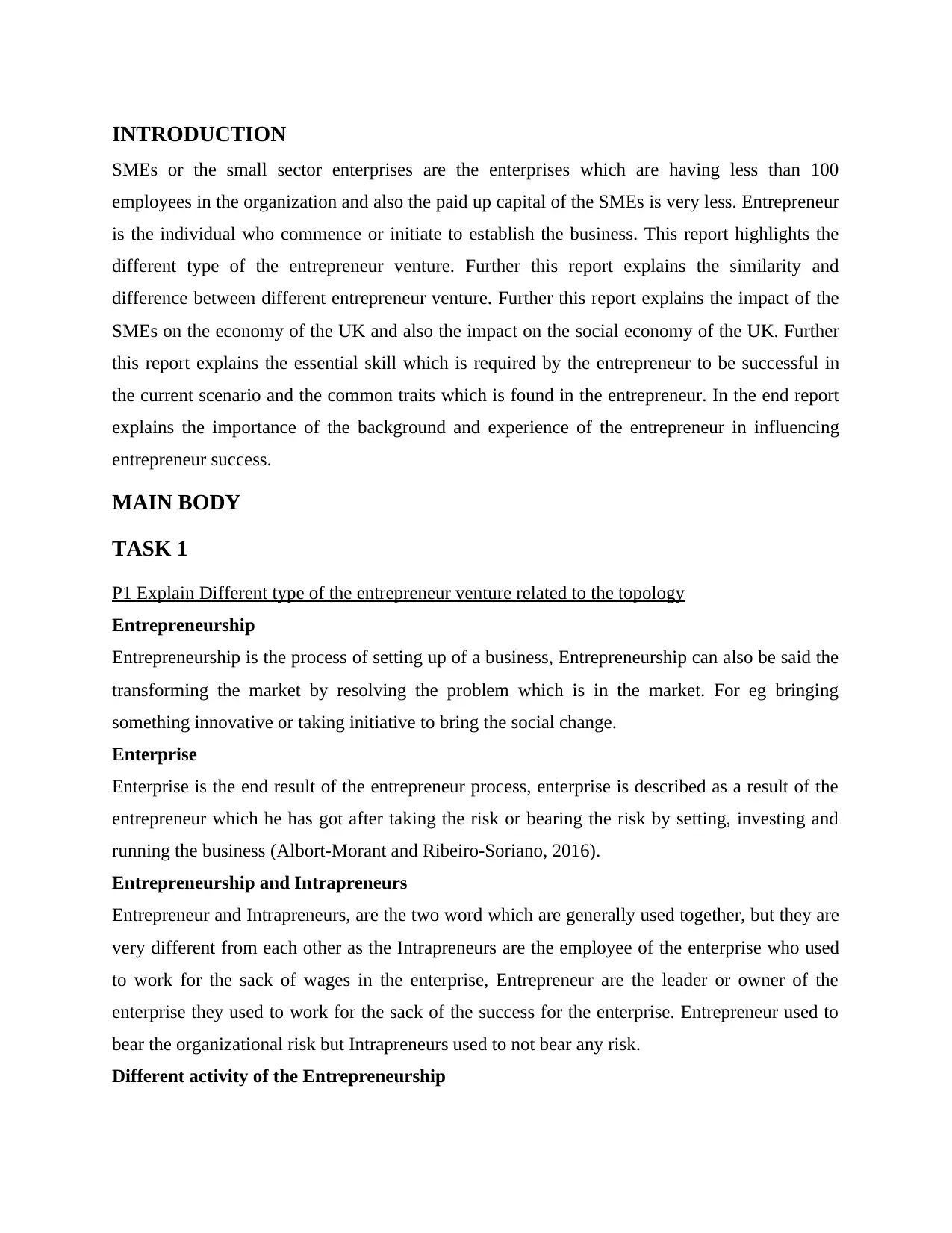
INTRODUCTION
SMEs or the small sector enterprises are the enterprises which are having less than 100
employees in the organization and also the paid up capital of the SMEs is very less. Entrepreneur
is the individual who commence or initiate to establish the business. This report highlights the
different type of the entrepreneur venture. Further this report explains the similarity and
difference between different entrepreneur venture. Further this report explains the impact of the
SMEs on the economy of the UK and also the impact on the social economy of the UK. Further
this report explains the essential skill which is required by the entrepreneur to be successful in
the current scenario and the common traits which is found in the entrepreneur. In the end report
explains the importance of the background and experience of the entrepreneur in influencing
entrepreneur success.
MAIN BODY
TASK 1
P1 Explain Different type of the entrepreneur venture related to the topology
Entrepreneurship
Entrepreneurship is the process of setting up of a business, Entrepreneurship can also be said the
transforming the market by resolving the problem which is in the market. For eg bringing
something innovative or taking initiative to bring the social change.
Enterprise
Enterprise is the end result of the entrepreneur process, enterprise is described as a result of the
entrepreneur which he has got after taking the risk or bearing the risk by setting, investing and
running the business (Albort-Morant and Ribeiro-Soriano, 2016).
Entrepreneurship and Intrapreneurs
Entrepreneur and Intrapreneurs, are the two word which are generally used together, but they are
very different from each other as the Intrapreneurs are the employee of the enterprise who used
to work for the sack of wages in the enterprise, Entrepreneur are the leader or owner of the
enterprise they used to work for the sack of the success for the enterprise. Entrepreneur used to
bear the organizational risk but Intrapreneurs used to not bear any risk.
Different activity of the Entrepreneurship
SMEs or the small sector enterprises are the enterprises which are having less than 100
employees in the organization and also the paid up capital of the SMEs is very less. Entrepreneur
is the individual who commence or initiate to establish the business. This report highlights the
different type of the entrepreneur venture. Further this report explains the similarity and
difference between different entrepreneur venture. Further this report explains the impact of the
SMEs on the economy of the UK and also the impact on the social economy of the UK. Further
this report explains the essential skill which is required by the entrepreneur to be successful in
the current scenario and the common traits which is found in the entrepreneur. In the end report
explains the importance of the background and experience of the entrepreneur in influencing
entrepreneur success.
MAIN BODY
TASK 1
P1 Explain Different type of the entrepreneur venture related to the topology
Entrepreneurship
Entrepreneurship is the process of setting up of a business, Entrepreneurship can also be said the
transforming the market by resolving the problem which is in the market. For eg bringing
something innovative or taking initiative to bring the social change.
Enterprise
Enterprise is the end result of the entrepreneur process, enterprise is described as a result of the
entrepreneur which he has got after taking the risk or bearing the risk by setting, investing and
running the business (Albort-Morant and Ribeiro-Soriano, 2016).
Entrepreneurship and Intrapreneurs
Entrepreneur and Intrapreneurs, are the two word which are generally used together, but they are
very different from each other as the Intrapreneurs are the employee of the enterprise who used
to work for the sack of wages in the enterprise, Entrepreneur are the leader or owner of the
enterprise they used to work for the sack of the success for the enterprise. Entrepreneur used to
bear the organizational risk but Intrapreneurs used to not bear any risk.
Different activity of the Entrepreneurship
Paraphrase This Document
Need a fresh take? Get an instant paraphrase of this document with our AI Paraphraser
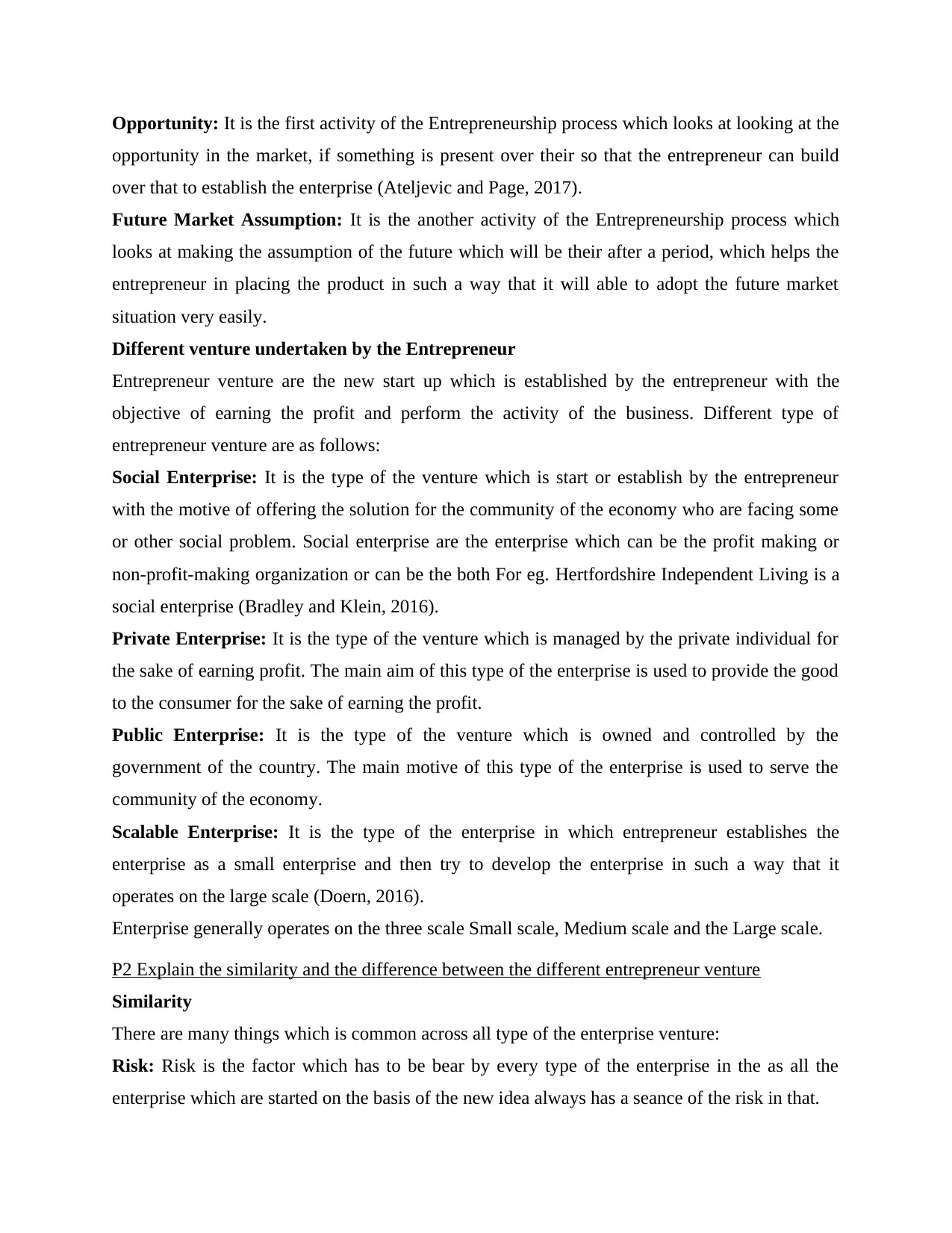
Opportunity: It is the first activity of the Entrepreneurship process which looks at looking at the
opportunity in the market, if something is present over their so that the entrepreneur can build
over that to establish the enterprise (Ateljevic and Page, 2017).
Future Market Assumption: It is the another activity of the Entrepreneurship process which
looks at making the assumption of the future which will be their after a period, which helps the
entrepreneur in placing the product in such a way that it will able to adopt the future market
situation very easily.
Different venture undertaken by the Entrepreneur
Entrepreneur venture are the new start up which is established by the entrepreneur with the
objective of earning the profit and perform the activity of the business. Different type of
entrepreneur venture are as follows:
Social Enterprise: It is the type of the venture which is start or establish by the entrepreneur
with the motive of offering the solution for the community of the economy who are facing some
or other social problem. Social enterprise are the enterprise which can be the profit making or
non-profit-making organization or can be the both For eg. Hertfordshire Independent Living is a
social enterprise (Bradley and Klein, 2016).
Private Enterprise: It is the type of the venture which is managed by the private individual for
the sake of earning profit. The main aim of this type of the enterprise is used to provide the good
to the consumer for the sake of earning the profit.
Public Enterprise: It is the type of the venture which is owned and controlled by the
government of the country. The main motive of this type of the enterprise is used to serve the
community of the economy.
Scalable Enterprise: It is the type of the enterprise in which entrepreneur establishes the
enterprise as a small enterprise and then try to develop the enterprise in such a way that it
operates on the large scale (Doern, 2016).
Enterprise generally operates on the three scale Small scale, Medium scale and the Large scale.
P2 Explain the similarity and the difference between the different entrepreneur venture
Similarity
There are many things which is common across all type of the enterprise venture:
Risk: Risk is the factor which has to be bear by every type of the enterprise in the as all the
enterprise which are started on the basis of the new idea always has a seance of the risk in that.
opportunity in the market, if something is present over their so that the entrepreneur can build
over that to establish the enterprise (Ateljevic and Page, 2017).
Future Market Assumption: It is the another activity of the Entrepreneurship process which
looks at making the assumption of the future which will be their after a period, which helps the
entrepreneur in placing the product in such a way that it will able to adopt the future market
situation very easily.
Different venture undertaken by the Entrepreneur
Entrepreneur venture are the new start up which is established by the entrepreneur with the
objective of earning the profit and perform the activity of the business. Different type of
entrepreneur venture are as follows:
Social Enterprise: It is the type of the venture which is start or establish by the entrepreneur
with the motive of offering the solution for the community of the economy who are facing some
or other social problem. Social enterprise are the enterprise which can be the profit making or
non-profit-making organization or can be the both For eg. Hertfordshire Independent Living is a
social enterprise (Bradley and Klein, 2016).
Private Enterprise: It is the type of the venture which is managed by the private individual for
the sake of earning profit. The main aim of this type of the enterprise is used to provide the good
to the consumer for the sake of earning the profit.
Public Enterprise: It is the type of the venture which is owned and controlled by the
government of the country. The main motive of this type of the enterprise is used to serve the
community of the economy.
Scalable Enterprise: It is the type of the enterprise in which entrepreneur establishes the
enterprise as a small enterprise and then try to develop the enterprise in such a way that it
operates on the large scale (Doern, 2016).
Enterprise generally operates on the three scale Small scale, Medium scale and the Large scale.
P2 Explain the similarity and the difference between the different entrepreneur venture
Similarity
There are many things which is common across all type of the enterprise venture:
Risk: Risk is the factor which has to be bear by every type of the enterprise in the as all the
enterprise which are started on the basis of the new idea always has a seance of the risk in that.
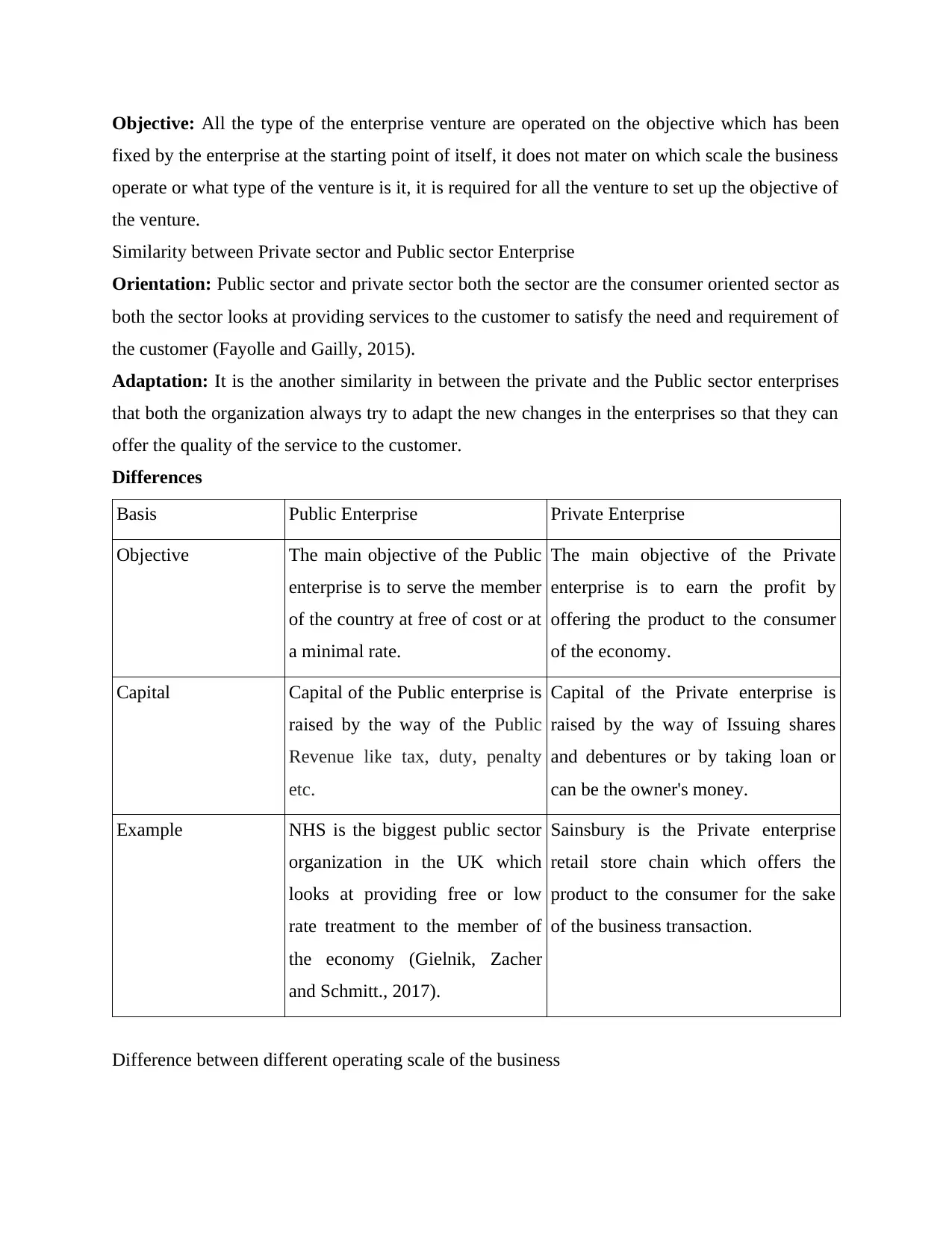
Objective: All the type of the enterprise venture are operated on the objective which has been
fixed by the enterprise at the starting point of itself, it does not mater on which scale the business
operate or what type of the venture is it, it is required for all the venture to set up the objective of
the venture.
Similarity between Private sector and Public sector Enterprise
Orientation: Public sector and private sector both the sector are the consumer oriented sector as
both the sector looks at providing services to the customer to satisfy the need and requirement of
the customer (Fayolle and Gailly, 2015).
Adaptation: It is the another similarity in between the private and the Public sector enterprises
that both the organization always try to adapt the new changes in the enterprises so that they can
offer the quality of the service to the customer.
Differences
Basis Public Enterprise Private Enterprise
Objective The main objective of the Public
enterprise is to serve the member
of the country at free of cost or at
a minimal rate.
The main objective of the Private
enterprise is to earn the profit by
offering the product to the consumer
of the economy.
Capital Capital of the Public enterprise is
raised by the way of the Public
Revenue like tax, duty, penalty
etc.
Capital of the Private enterprise is
raised by the way of Issuing shares
and debentures or by taking loan or
can be the owner's money.
Example NHS is the biggest public sector
organization in the UK which
looks at providing free or low
rate treatment to the member of
the economy (Gielnik, Zacher
and Schmitt., 2017).
Sainsbury is the Private enterprise
retail store chain which offers the
product to the consumer for the sake
of the business transaction.
Difference between different operating scale of the business
fixed by the enterprise at the starting point of itself, it does not mater on which scale the business
operate or what type of the venture is it, it is required for all the venture to set up the objective of
the venture.
Similarity between Private sector and Public sector Enterprise
Orientation: Public sector and private sector both the sector are the consumer oriented sector as
both the sector looks at providing services to the customer to satisfy the need and requirement of
the customer (Fayolle and Gailly, 2015).
Adaptation: It is the another similarity in between the private and the Public sector enterprises
that both the organization always try to adapt the new changes in the enterprises so that they can
offer the quality of the service to the customer.
Differences
Basis Public Enterprise Private Enterprise
Objective The main objective of the Public
enterprise is to serve the member
of the country at free of cost or at
a minimal rate.
The main objective of the Private
enterprise is to earn the profit by
offering the product to the consumer
of the economy.
Capital Capital of the Public enterprise is
raised by the way of the Public
Revenue like tax, duty, penalty
etc.
Capital of the Private enterprise is
raised by the way of Issuing shares
and debentures or by taking loan or
can be the owner's money.
Example NHS is the biggest public sector
organization in the UK which
looks at providing free or low
rate treatment to the member of
the economy (Gielnik, Zacher
and Schmitt., 2017).
Sainsbury is the Private enterprise
retail store chain which offers the
product to the consumer for the sake
of the business transaction.
Difference between different operating scale of the business
⊘ This is a preview!⊘
Do you want full access?
Subscribe today to unlock all pages.

Trusted by 1+ million students worldwide

Enterprise having less than 100 employees are known as a small enterprise, enterprise having
employee in between 100-499 is known as a medium scale enterprises and the enterprises having
more than 500 employees are categorized as large business (Small Enterprise, 2016).
P3 Explain the relevant data and stats to explain the impact of the SMEs on the economy
SMEs or the micro business are known as a living blood of the UK economy as they used to
contribute very well toward the economy of the country, some evaluator also called SMEs as the
back corn of the economy as they are the one who contribute total of 99.3 percent of the total
private sector in the economy and as the market cover by the SMEs is to large it also helps the
economy in many ways some ways are as follows:
Employment: It is the biggest plus point which is brought by the SMEs and micro business in
the economy which relates to providing the employment to the human resource of the economy
as this is the biggest issue which is faced by the every economy in the current scenario but the
present of this number of the SMEs in the UK economy has helped the UK economy in
defending it as SMEs account for the 48% of all the employment which has been provided in the
economy in the year 2016, in number it is 15.7 million employee. Not only this in the year itself
there are 14000 business which are employing. This has benefited the UK economy as there is
the minimum wastage of the human resources (McMullen, 2019).
Competition: It is the another factor which has been brought on by the SMEs in the UK
economy as the number of enterprises is increasing and as the new enterprises in the market is
forcing the other enterprises to offer the good quality of the product in the market which is
helping the economy as the quality of the life of the consumer is increasing in the economy.
Number of the business launched in the year 2016 only are 97,000 which is a good number.
Innovation and creativity: This is the two big thing which is brought by the SMEs in the
market as all the SMEs and micro enterprises are incorporated with the new idea in the market
which helps them in earning the good attention from the customer side which eventually result in
increase in the revenue of the enterprises which contribute positively towards the economy of the
UK. The turnover of the SMEs is account to be 1.8 million pound which is 47 percent of the total
turnover of the private sector. Number of the business which are register under Payee/VAT in the
year 2016 is 101,000 (Staniewski, 2016) (Stats of the SMEs, 2016).
employee in between 100-499 is known as a medium scale enterprises and the enterprises having
more than 500 employees are categorized as large business (Small Enterprise, 2016).
P3 Explain the relevant data and stats to explain the impact of the SMEs on the economy
SMEs or the micro business are known as a living blood of the UK economy as they used to
contribute very well toward the economy of the country, some evaluator also called SMEs as the
back corn of the economy as they are the one who contribute total of 99.3 percent of the total
private sector in the economy and as the market cover by the SMEs is to large it also helps the
economy in many ways some ways are as follows:
Employment: It is the biggest plus point which is brought by the SMEs and micro business in
the economy which relates to providing the employment to the human resource of the economy
as this is the biggest issue which is faced by the every economy in the current scenario but the
present of this number of the SMEs in the UK economy has helped the UK economy in
defending it as SMEs account for the 48% of all the employment which has been provided in the
economy in the year 2016, in number it is 15.7 million employee. Not only this in the year itself
there are 14000 business which are employing. This has benefited the UK economy as there is
the minimum wastage of the human resources (McMullen, 2019).
Competition: It is the another factor which has been brought on by the SMEs in the UK
economy as the number of enterprises is increasing and as the new enterprises in the market is
forcing the other enterprises to offer the good quality of the product in the market which is
helping the economy as the quality of the life of the consumer is increasing in the economy.
Number of the business launched in the year 2016 only are 97,000 which is a good number.
Innovation and creativity: This is the two big thing which is brought by the SMEs in the
market as all the SMEs and micro enterprises are incorporated with the new idea in the market
which helps them in earning the good attention from the customer side which eventually result in
increase in the revenue of the enterprises which contribute positively towards the economy of the
UK. The turnover of the SMEs is account to be 1.8 million pound which is 47 percent of the total
turnover of the private sector. Number of the business which are register under Payee/VAT in the
year 2016 is 101,000 (Staniewski, 2016) (Stats of the SMEs, 2016).
Paraphrase This Document
Need a fresh take? Get an instant paraphrase of this document with our AI Paraphraser
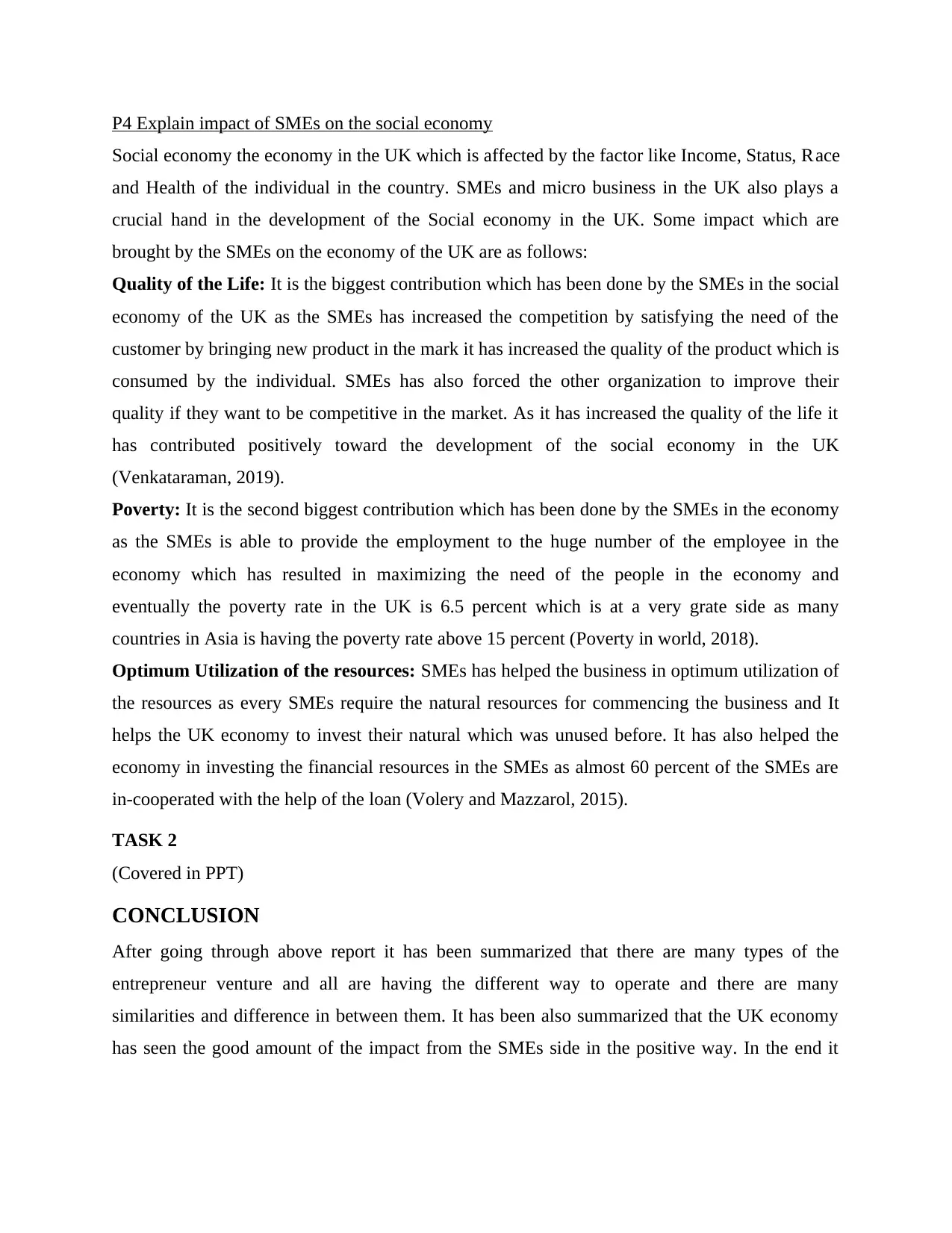
P4 Explain impact of SMEs on the social economy
Social economy the economy in the UK which is affected by the factor like Income, Status, Race
and Health of the individual in the country. SMEs and micro business in the UK also plays a
crucial hand in the development of the Social economy in the UK. Some impact which are
brought by the SMEs on the economy of the UK are as follows:
Quality of the Life: It is the biggest contribution which has been done by the SMEs in the social
economy of the UK as the SMEs has increased the competition by satisfying the need of the
customer by bringing new product in the mark it has increased the quality of the product which is
consumed by the individual. SMEs has also forced the other organization to improve their
quality if they want to be competitive in the market. As it has increased the quality of the life it
has contributed positively toward the development of the social economy in the UK
(Venkataraman, 2019).
Poverty: It is the second biggest contribution which has been done by the SMEs in the economy
as the SMEs is able to provide the employment to the huge number of the employee in the
economy which has resulted in maximizing the need of the people in the economy and
eventually the poverty rate in the UK is 6.5 percent which is at a very grate side as many
countries in Asia is having the poverty rate above 15 percent (Poverty in world, 2018).
Optimum Utilization of the resources: SMEs has helped the business in optimum utilization of
the resources as every SMEs require the natural resources for commencing the business and It
helps the UK economy to invest their natural which was unused before. It has also helped the
economy in investing the financial resources in the SMEs as almost 60 percent of the SMEs are
in-cooperated with the help of the loan (Volery and Mazzarol, 2015).
TASK 2
(Covered in PPT)
CONCLUSION
After going through above report it has been summarized that there are many types of the
entrepreneur venture and all are having the different way to operate and there are many
similarities and difference in between them. It has been also summarized that the UK economy
has seen the good amount of the impact from the SMEs side in the positive way. In the end it
Social economy the economy in the UK which is affected by the factor like Income, Status, Race
and Health of the individual in the country. SMEs and micro business in the UK also plays a
crucial hand in the development of the Social economy in the UK. Some impact which are
brought by the SMEs on the economy of the UK are as follows:
Quality of the Life: It is the biggest contribution which has been done by the SMEs in the social
economy of the UK as the SMEs has increased the competition by satisfying the need of the
customer by bringing new product in the mark it has increased the quality of the product which is
consumed by the individual. SMEs has also forced the other organization to improve their
quality if they want to be competitive in the market. As it has increased the quality of the life it
has contributed positively toward the development of the social economy in the UK
(Venkataraman, 2019).
Poverty: It is the second biggest contribution which has been done by the SMEs in the economy
as the SMEs is able to provide the employment to the huge number of the employee in the
economy which has resulted in maximizing the need of the people in the economy and
eventually the poverty rate in the UK is 6.5 percent which is at a very grate side as many
countries in Asia is having the poverty rate above 15 percent (Poverty in world, 2018).
Optimum Utilization of the resources: SMEs has helped the business in optimum utilization of
the resources as every SMEs require the natural resources for commencing the business and It
helps the UK economy to invest their natural which was unused before. It has also helped the
economy in investing the financial resources in the SMEs as almost 60 percent of the SMEs are
in-cooperated with the help of the loan (Volery and Mazzarol, 2015).
TASK 2
(Covered in PPT)
CONCLUSION
After going through above report it has been summarized that there are many types of the
entrepreneur venture and all are having the different way to operate and there are many
similarities and difference in between them. It has been also summarized that the UK economy
has seen the good amount of the impact from the SMEs side in the positive way. In the end it

was summarized that the Background of the entrepreneur play a crucial role in influencing the
entrepreneur personality and success.
entrepreneur personality and success.
⊘ This is a preview!⊘
Do you want full access?
Subscribe today to unlock all pages.

Trusted by 1+ million students worldwide
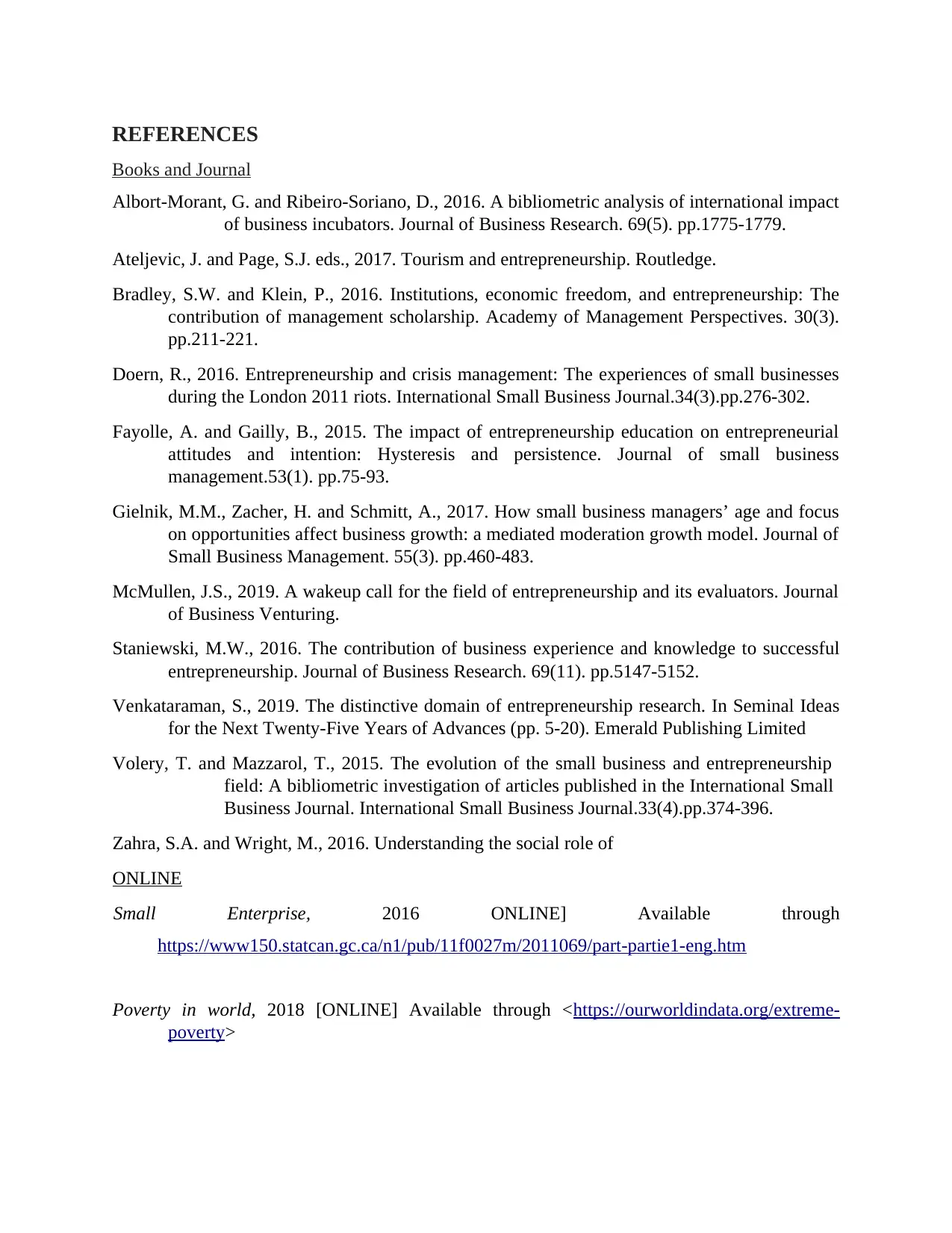
REFERENCES
Books and Journal
Albort-Morant, G. and Ribeiro-Soriano, D., 2016. A bibliometric analysis of international impact
of business incubators. Journal of Business Research. 69(5). pp.1775-1779.
Ateljevic, J. and Page, S.J. eds., 2017. Tourism and entrepreneurship. Routledge.
Bradley, S.W. and Klein, P., 2016. Institutions, economic freedom, and entrepreneurship: The
contribution of management scholarship. Academy of Management Perspectives. 30(3).
pp.211-221.
Doern, R., 2016. Entrepreneurship and crisis management: The experiences of small businesses
during the London 2011 riots. International Small Business Journal.34(3).pp.276-302.
Fayolle, A. and Gailly, B., 2015. The impact of entrepreneurship education on entrepreneurial
attitudes and intention: Hysteresis and persistence. Journal of small business
management.53(1). pp.75-93.
Gielnik, M.M., Zacher, H. and Schmitt, A., 2017. How small business managers’ age and focus
on opportunities affect business growth: a mediated moderation growth model. Journal of
Small Business Management. 55(3). pp.460-483.
McMullen, J.S., 2019. A wakeup call for the field of entrepreneurship and its evaluators. Journal
of Business Venturing.
Staniewski, M.W., 2016. The contribution of business experience and knowledge to successful
entrepreneurship. Journal of Business Research. 69(11). pp.5147-5152.
Venkataraman, S., 2019. The distinctive domain of entrepreneurship research. In Seminal Ideas
for the Next Twenty-Five Years of Advances (pp. 5-20). Emerald Publishing Limited
Volery, T. and Mazzarol, T., 2015. The evolution of the small business and entrepreneurship
field: A bibliometric investigation of articles published in the International Small
Business Journal. International Small Business Journal.33(4).pp.374-396.
Zahra, S.A. and Wright, M., 2016. Understanding the social role of
ONLINE
Small Enterprise, 2016 ONLINE] Available through
https://www150.statcan.gc.ca/n1/pub/11f0027m/2011069/part-partie1-eng.htm
Poverty in world, 2018 [ONLINE] Available through <https://ourworldindata.org/extreme-
poverty>
Books and Journal
Albort-Morant, G. and Ribeiro-Soriano, D., 2016. A bibliometric analysis of international impact
of business incubators. Journal of Business Research. 69(5). pp.1775-1779.
Ateljevic, J. and Page, S.J. eds., 2017. Tourism and entrepreneurship. Routledge.
Bradley, S.W. and Klein, P., 2016. Institutions, economic freedom, and entrepreneurship: The
contribution of management scholarship. Academy of Management Perspectives. 30(3).
pp.211-221.
Doern, R., 2016. Entrepreneurship and crisis management: The experiences of small businesses
during the London 2011 riots. International Small Business Journal.34(3).pp.276-302.
Fayolle, A. and Gailly, B., 2015. The impact of entrepreneurship education on entrepreneurial
attitudes and intention: Hysteresis and persistence. Journal of small business
management.53(1). pp.75-93.
Gielnik, M.M., Zacher, H. and Schmitt, A., 2017. How small business managers’ age and focus
on opportunities affect business growth: a mediated moderation growth model. Journal of
Small Business Management. 55(3). pp.460-483.
McMullen, J.S., 2019. A wakeup call for the field of entrepreneurship and its evaluators. Journal
of Business Venturing.
Staniewski, M.W., 2016. The contribution of business experience and knowledge to successful
entrepreneurship. Journal of Business Research. 69(11). pp.5147-5152.
Venkataraman, S., 2019. The distinctive domain of entrepreneurship research. In Seminal Ideas
for the Next Twenty-Five Years of Advances (pp. 5-20). Emerald Publishing Limited
Volery, T. and Mazzarol, T., 2015. The evolution of the small business and entrepreneurship
field: A bibliometric investigation of articles published in the International Small
Business Journal. International Small Business Journal.33(4).pp.374-396.
Zahra, S.A. and Wright, M., 2016. Understanding the social role of
ONLINE
Small Enterprise, 2016 ONLINE] Available through
https://www150.statcan.gc.ca/n1/pub/11f0027m/2011069/part-partie1-eng.htm
Poverty in world, 2018 [ONLINE] Available through <https://ourworldindata.org/extreme-
poverty>
Paraphrase This Document
Need a fresh take? Get an instant paraphrase of this document with our AI Paraphraser

Stats of the SMEs, 2016 [ONLINE] Available through
<https://assets.publishing.service.gov.uk/government/uploads/system/uploads/
attachment_data/file/559219/bpe_2016_statistical_release.pdf>
<https://assets.publishing.service.gov.uk/government/uploads/system/uploads/
attachment_data/file/559219/bpe_2016_statistical_release.pdf>

⊘ This is a preview!⊘
Do you want full access?
Subscribe today to unlock all pages.

Trusted by 1+ million students worldwide
1 out of 12
Related Documents
Your All-in-One AI-Powered Toolkit for Academic Success.
+13062052269
info@desklib.com
Available 24*7 on WhatsApp / Email
![[object Object]](/_next/static/media/star-bottom.7253800d.svg)
Unlock your academic potential
Copyright © 2020–2025 A2Z Services. All Rights Reserved. Developed and managed by ZUCOL.





